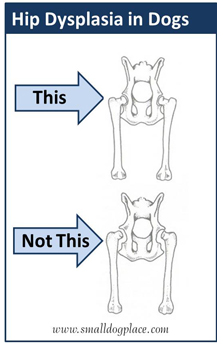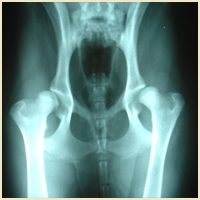 Hip dysplasia (HD) is a developmental abnormality of the hip joint (typically both) occurring in medium and large breed dogs. The causes include genetic predisposition, rapid growth rate, and overfeeding which leads to rapid growth. Puppies with a genetic predisposition have normal hips at birth, but develop instability often before twelve months of age. The dog may soon show signs of difficulty rising, a bunny-hopping gait in the rear limbs, and pain evidenced by a decrease in activities. Early in the disease a veterinarian my be able to palpate laxity, or looseness in the hip joints, but as time goes by the body applies abnormal fiberous tissue to provide support and reduce the laxity.
Hip dysplasia (HD) is a developmental abnormality of the hip joint (typically both) occurring in medium and large breed dogs. The causes include genetic predisposition, rapid growth rate, and overfeeding which leads to rapid growth. Puppies with a genetic predisposition have normal hips at birth, but develop instability often before twelve months of age. The dog may soon show signs of difficulty rising, a bunny-hopping gait in the rear limbs, and pain evidenced by a decrease in activities. Early in the disease a veterinarian my be able to palpate laxity, or looseness in the hip joints, but as time goes by the body applies abnormal fiberous tissue to provide support and reduce the laxity.
As the disease continues to progress, arthritis develops, pain increases, and the dog’s develop an abnormal gait. The rate at which hip dysplasia progresses is variable among individuals; some are very lame by a year of age, and others not until middle age. It has been proven that puppies with a genetic predisposition for hip dysplasia develop the disease much later if they are kept at a light weight.
 There are several surgical considerations to improve HD depending on the age of the dog, the severity of the condition, and the financial ability of the owner. All of these are improved with dog rehabilitation exercises after surgery. But what about the ones who don’t go to surgery? What can rehab do for them?
There are several surgical considerations to improve HD depending on the age of the dog, the severity of the condition, and the financial ability of the owner. All of these are improved with dog rehabilitation exercises after surgery. But what about the ones who don’t go to surgery? What can rehab do for them?
Modalities like therapeutic ultrasound, e-stim, or laser can decrease pain. Exercises targeted to strengthening those weakened muscles and improving the joint’s range of motion can be beneficial for the entire limb. If one joint in a limb is having problems, the other joints will also be stressed. Stretches and strengthening will improve the joint’s mobility, and allow the dog to walk with an improved gait.
A diagnosis of hip dysplasia is always sad, but early rehab may decrease the rate of progression and make the dog more comfortable.

Recent Comments